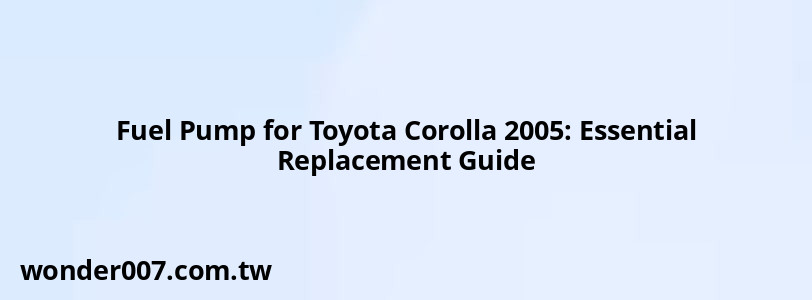Fuel Pump for Toyota Corolla 2005: Essential Replacement Guide

The fuel pump is a crucial component of your 2005 Toyota Corolla's fuel system, responsible for delivering gasoline from the tank to the engine. Understanding its role and knowing when to replace it can significantly enhance your vehicle's performance and longevity.
Importance of the Fuel Pump
The fuel pump operates by generating high pressure within the fuel lines, ensuring that an adequate supply of fuel reaches the engine. A malfunctioning fuel pump can lead to various issues, including poor engine performance, stalling, or difficulty starting the vehicle. Regular maintenance and timely replacement are essential to avoid these problems.
Signs of a Failing Fuel Pump
Recognizing when your fuel pump needs replacement is vital. Here are some important signs to watch for:
- Difficulty starting the engine
- Engine stalling or sputtering
- Decreased acceleration or power
- Unusual noises from the fuel tank area
- Warning lights on the dashboard
If you experience any of these symptoms, it may be time to inspect or replace your fuel pump.
Replacement Process
Replacing the fuel pump in a 2005 Toyota Corolla can be done with some mechanical knowledge. Here’s a simplified overview of the steps involved:
1. Preparation: Gather necessary tools such as screwdrivers, wrenches, and safety gear. Ensure you have a replacement fuel pump compatible with your vehicle model.
2. Safety First: Disconnect the negative battery terminal to prevent electrical hazards. Relieve fuel system pressure by removing the fuel cap and following manufacturer guidelines.
3. Accessing the Fuel Pump: The fuel pump is located underneath the rear seat. Remove the seat cushion to access the fuel pump cover.
4. Removing the Old Pump: Unscrew and detach any retaining clips or screws holding the pump in place. Carefully disconnect the electrical connectors and fuel lines.
5. Installing the New Pump: Position the new pump into place, ensuring it aligns correctly with any mounting points. Reconnect all electrical connections and secure it with retaining clips.
6. Reassembly: Replace the access cover and seat cushion. Reconnect the negative battery terminal.
7. Testing: Turn on the ignition without starting the engine to prime the fuel system, then check for leaks before taking your vehicle for a test drive.
Choosing a Replacement Fuel Pump
When selecting a replacement fuel pump, consider these factors:
- OEM vs Aftermarket: Original Equipment Manufacturer (OEM) parts are generally recommended for reliability and compatibility.
- Quality Brands: Look for reputable brands such as Denso or Delphi, known for their quality in automotive parts.
- Cost Considerations: Prices can vary widely based on brand and type; expect to pay between $100 to $300 for a quality fuel pump.
FAQs About Fuel Pumps
- How often should I replace my fuel pump?
Fuel pumps typically last between 100,000 to 150,000 miles but should be inspected regularly. - Can I replace my fuel pump myself?
Yes, if you have basic mechanical skills and tools, you can replace it yourself. - What happens if I ignore a failing fuel pump?
Ignoring a failing fuel pump can lead to more severe engine problems and costly repairs.
Maintaining your 2005 Toyota Corolla's fuel system is essential for optimal performance and reliability. By understanding when and how to replace your fuel pump, you can ensure your vehicle runs smoothly for years to come.
Related Posts
-
2017 Hyundai Santa Fe: Essential Coolant Information
29-01-2025 • 207 views -
Idle Air Control Valve Hyundai Elantra: Essential Guide
29-01-2025 • 188 views -
Toyota Corolla Locking Wheel Nut Key Location Guide
26-01-2025 • 148 views -
Kia Optima Front Wheel Bearing Replacement Guide
27-01-2025 • 131 views -
Firing Order for 2005 Hyundai Tucson 2.7: Essential Guide
29-01-2025 • 145 views
Latest Posts
-
2015 Chevy Traverse AC Recharge Port Location
01-02-2025 • 409 views -
How To Turn Off Paddle Shifters Mercedes
01-02-2025 • 377 views -
Rear Brake Caliper Piston Won't Compress
01-02-2025 • 356 views -
Power Steering Fluid Leak On Passenger Side
01-02-2025 • 457 views -
Are O2 Sensors Covered Under Warranty
01-02-2025 • 376 views
Popular Posts
-
Power Steering and ABS Light On: Causes and Solutions
27-01-2025 • 643 views -
EPC Light: Understanding Causes and Solutions
26-01-2025 • 1053 views -
EPC Warning Light: What It Means for Your Vehicle
27-01-2025 • 630 views -
Hino Warning Lights: Understanding Dashboard Alerts
26-01-2025 • 765 views -
V12 Engine Costs: What You Need to Know
26-01-2025 • 679 views
